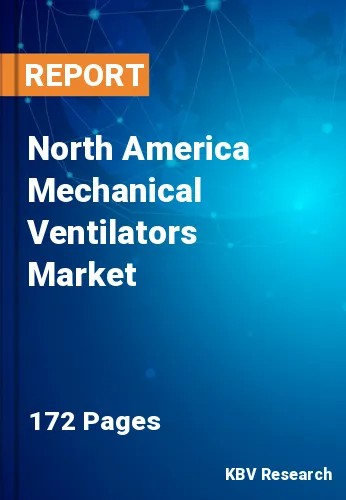The North America Mechanical Ventilators Market would witness market growth of 11.9% CAGR during the forecast period (2023-2030). In the year 2019, the North America market's volume surged to 181.3 thousand units, showcasing a growth of 26.5% (2019-2022).
The primary function of a mechanical ventilator is to assist individuals in breathing. This is crucial for patients with respiratory failure, as it ensures that the body receives an adequate oxygen supply and removes carbon dioxide effectively. Ventilators can provide controlled and regulated ventilation, enabling healthcare professionals to set parameters such as tidal volume, respiratory rate, and positive end-expiratory pressure (PEEP). They also serve as an essential tool for delivering supplemental oxygen to patients who may not require full ventilatory support. This function is crucial for managing hypoxemia, a condition characterized by low blood oxygen levels.
Integrating telemedicine and remote monitoring capabilities into mechanical ventilators has gained momentum. This allows healthcare providers to remotely assess patients, adjust ventilator settings, and provide real-time care, improving access to healthcare services. Innovative ventilation techniques, such as non-invasive ventilation (NIV) and high-flow nasal cannula (HFNC), are gaining popularity. Hybrid ventilation systems combine invasive and non-invasive modes to offer flexibility in patient care. Patient interfaces, such as masks and breathing circuits, have undergone significant improvements to enhance comfort and reduce complications. Innovations in mask design and materials have made non-invasive ventilation more effective and user-friendly.
According to the National Library of Medicine, the estimated number of new lung cancer cases in the US in 2018 was 121,680 for men and 112,350 for women, 234,030, or 641 cases per day. Lung carcinoma is the third most prevalent cancer by gender, following prostate cancer for men and breast cancer for women. As per the Canadian Institute of Health Information, the number of Canadians 65 and older is projected to increase by 68% in the next 20 years. Its size has increased by more than threefold in the last 40 years. The population in Canada is projected to increase by 2.1 times by 2037 from its size in 2017. Due to the above-mentioned factors, the market will grow significantly in this region.
The US market dominated the North America Mechanical Ventilator Market by Country in 2022 and would continue to be a dominant market till 2030; thereby, achieving a market value of $4,261.1 million by 2030. The Canada market is experiencing a CAGR of 14.4% during (2023 - 2030). Additionally, The Mexico market would exhibit a CAGR of 13.4% during (2023 - 2030).
Based on Mode, the market is segmented into Invasive Ventilation, and Non-invasive Ventilation. Based on Component, the market is segmented into Devices, and Services. Based on Product Type, the market is segmented into Intensive Care Unit/Critical Care, Transport/Portable/Ambulatory, and Neonatal Care. Based on Age Group, the market is segmented into Adult, Geriatric, and Pediatric & Neonatal. Based on End User, the market is segmented into Hospital & Clinic, Ambulatory Surgical Center, Home Care, and Others. Based on countries, the market is segmented into U.S., Mexico, Canada, and Rest of North America.
Free Valuable Insights: The Mechanical Ventilators Market is Predict to reach $16.7 Billion by 2030, at a CAGR of 12.6%
The market research report covers the analysis of key stake holders of the market. Key companies profiled in the report include GE HealthCare Technologies, Inc., Koninklijke Philips N.V., Medtronic PLC, Dragerwerk AG & Co. KGaA, Getinge AB, Asahi Kasei Corporation (Zoll Medical Corporation), Hamilton Medical AG (Hamilton Bonaduz AG), Carl Reiner GmbH, Mindray Medical International Limited and Vyaire Medical, Inc.
By Mode (Volume, Thousand Unit, USD Billion, 2019-30)
By Component (Volume, Thousand Unit, USD Billion, 2019-30)
By Product Type (Volume, Thousand Unit, USD Billion, 2019-30)
By Age Group (Volume, Thousand Unit, USD Billion, 2019-30)
By End User (Volume, Thousand Unit, USD Billion, 2019-30)
By Country (Volume, Thousand Unit, USD Billion, 2019-30)
Our team of dedicated experts can provide you with attractive expansion opportunities for your business.

